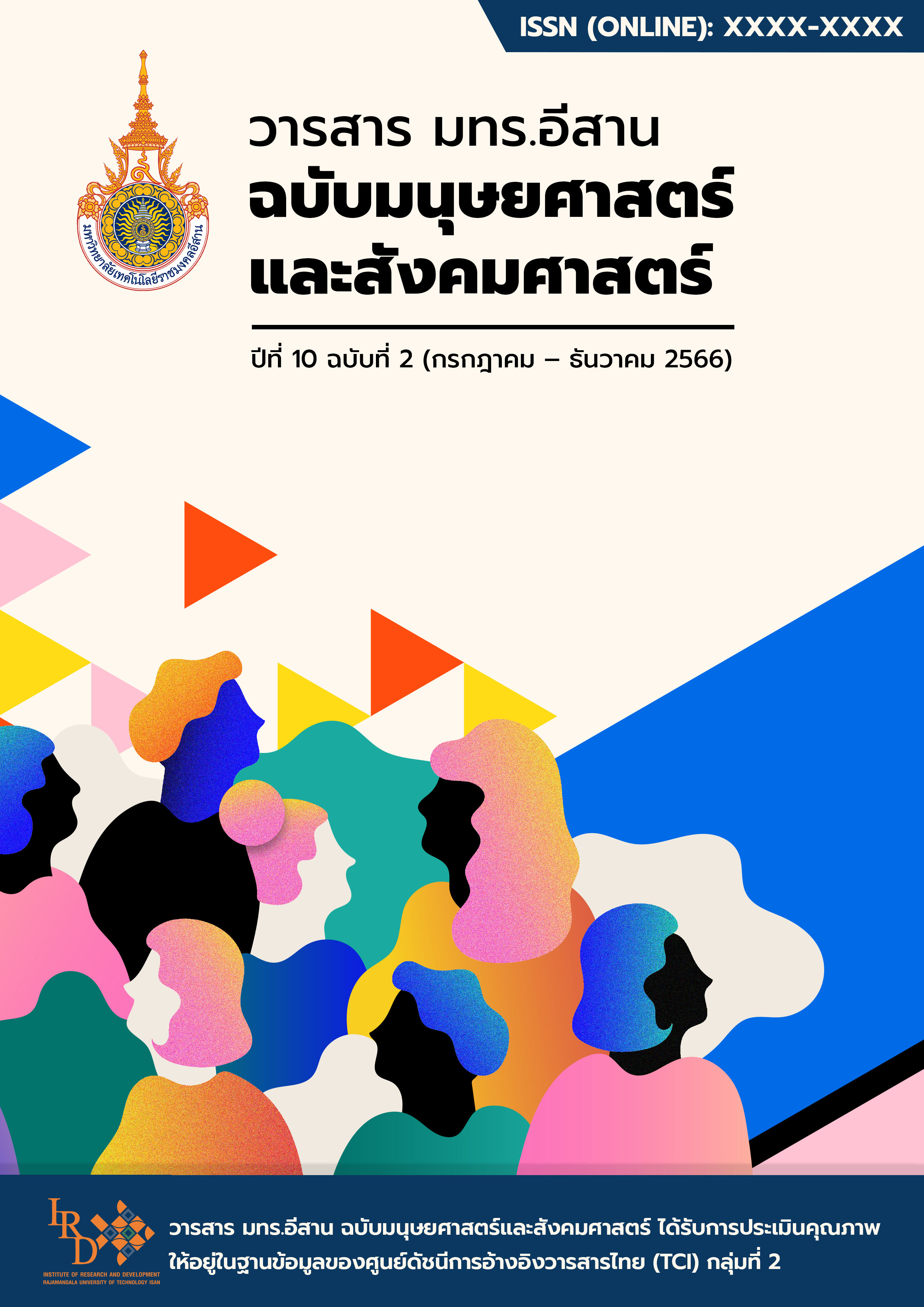Working Behavior Affecting Organizational Culture of Production Employees in Ayutthaya Province Using the DISC Model
Main Article Content
Abstract
DISC model is a tool that characterizes human behavior, which shows the differences in behavioral expressions. The objective of this study was to help employees understand and work together more efficiently and happily. The study sample was a selected group of employees in Ayutthaya Province whose behaviors were studied and ways to manage them proposed. The Research tool was behavior assessment questionnaires which were developed by DISC conceptual frameworks. The questionnaires used five level measurements that were approved by 3 experts in related field. The Cronbach's alpha was 0.84 with a sample of 400 production employees using proportional stratified random sampling. The statistics used included mean, standard deviation, and Explorer Factor Analysis (EFA). and Th research. results grouped the behavior of employees into 4 elements: 1) “Work-oriented” behavior, 2)“Discipline” behavior, 3) “Employee oriented” behavior, and 4) “skeptical” behavior. In addition, it was found that the dominance of the organizational culture were employee oriented, discipline, work-oriented, and skeptical variables as 434, .189, .143 and -.136, respectively. Employees should be encouraged to have employee oriented, discipline, work-oriented, and reduce skeptical behaviour. The prediction results were 39 percent (R Square = .392).
Article Details

This work is licensed under a Creative Commons Attribution-NonCommercial-NoDerivatives 4.0 International License.
บทความที่ได้รับการตีพิมพ์เป็นลิขสิทธิ์ของมหาวิทยาลัยเทคโนโลยีราชมงคลอีสาน
ข้อความที่ปรากฏในบทความแต่ละเรื่องในวารสารวิชาการเล่มนี้เป็นความคิดเห็นส่วนตัวของผู้เขียนแต่ละท่านไม่เกี่ยวข้องกับมหาวิทยาลัยเทคโนโลยีราชมงคลอีสานและคณาจารย์ท่านอื่นๆในมหาวิทยาลัยฯ แต่อย่างใด ความรับผิดชอบองค์ประกอบทั้งหมดของบทความแต่ละเรื่องเป็นของผู้เขียนแต่ละท่าน หากมีความผิดพลาดใดๆ ผู้เขียนแต่ละท่านจะรับผิดชอบบทความของตนเองแต่ผู้เดียว
References
จิรภิญญา จิรไพศาลกุล. (2562). บุคลิกภาพที่ส่งผลต่อความต้องการคุณลักษณะงานของพนักงานบริษัทเอกชน กลุ่มเจเนอเรชั่นวาย. ปริญญาการจัดการมหาบัณฑิต วิทยาลัยการจัดการ มหาวิทยาลัยมหิดล
ฉัตรชัย นาถํ่าพลอย. (2562). การบริหารงานแบบมุ่งผลสัมฤทธิ์ในสังคมปัจจุบัน. วารสารนวัตกรรมการศึกษาและการวิจัย. ปีที่ 3, ฉบับที่ 3, หน้า 171-178
ธานินทร์ ศิลป์จารุ. (2555). การวิจัยและวิเคราะห์ข้อมูลทางสถิติด้วย SPSS และ AMOS. พิมพ์ครั้งที่ 13. กรุงเทพฯ : บิสซิเนสอาร์แอนด์ดี
พรเพ็ญ พุทธิมา, อำภาพรรณ ตันตินาครกูล และปริยาภรณ์ ตั้งคุณานันต์. (2564). การวิเคราะห์องค์ประกอบภาวะผู้นำในศตวรรษที่ 21 ของหัวหน้าแผนกวิชาในสถานศึกษา สังกัดสำนักงานคณะกรรมการการอาชีวศึกษา เขตภาคกลาง. วารสาร มทร.อีสาน ฉบับมนุษยศาสตร์และสังคมศาสตร์. ปีที่ 8, ฉบับที่ 1, หน้า 51-67
วรรณี งามขจรกุลกิจ. (2562). การเข้าใจ เข้าถึงผู้เรียนยุคดิจิทัลด้วย DISC Model. In Proceedings of EXHIBITION IN TEACHING & LEARNING. หน้า 157-173
ศุทธกานต์ มิตรกูล และอนันต์ชัย คงจันทร์. (2559). เจเนอเรชันวายในองค์กร: การศึกษาความสัมพันธ์ระหว่างความสอดคล้องของค่านิยมกับความผูกพันต่อองค์กร. วารสารวิทยาการจัดการ. ปีที่ 33, ฉบับที่ 1, หน้า 51-75
สรวงอัยย์ อนันทวิจักษณ์, ไพโรจน์ พิภพเอกสิทธิ์, คุณากร วุฒิโยธิน, พงศธร แพรสุรินทร์ และภาณุพงศ์ มงคลชัยทรัพย์. (2564). การศึกษาคุณลักษณะและพฤติกรรมของผู้นำในวรรณกรรมสามก๊กที่ส่งผลเสียต่อการบริหารจัดการองค์กร. วารสารการบริหารท้องถิ่น (Local Administration Journal). ปีที่ 14, ฉบับที่ 2, หน้า 195-212
เสฎฐวุฒิ หนุ่มคำ, สัชฌุเศรษฐ์ เรืองเดชสุวรรณ และสมปรารถนา ประกัตฐโกมล. (2559). แนวคิดและพฤติกรรมการปฏิบัติงานร่วมกันตามคุณลักษณะด้านทักษะและอาชีพในศตวรรษที่ 21 ของเจเนอเรชั่นวายและเจเนอเรชั่นเอ็กซ์. วารสารวิชาการมหาวิทยาลัยฟาร์อีสเทอร์น. ปีที่ 10 ฉบับที่ 4, หน้า 248-248
Brazel, J. F. (2016). The Outcome Effect and Professional Skepticism. Current Issues in Auditing. Vol. 13, No. 1, pp. P7-P16. DOI: 10.2308/ciia-52337
Clarke, J. T. (1964). Simplified “Disc” (Polyacrylamide Gel) Electrophoresis. Annals of the New York Academy of Sciences. Vol. 121, Issue 2, pp. 428-436. DOI: 10.1111/j.1749-6632.1964.tb14214.x
Gay, F. (2017). Develop Organizations Through People. Access (24 February 2021). Available (https://persolog.com/)
Hair, J., and Anderson, R. (1995). Multivariate Data Analysis. Prentice-Hall Inc. Access (24 February 2021). Available (https://thomasthailand.co/perspective/disc-model)
Haryadi, D. (2022). The Role of Organizational Culture on Improving Employee Performance Through Work Discipline. Jurnal Mantik. Vol. 6, No. 1, pp. 686-698
Hu, Q., Dinev, T., Hart, P., and Cooke, D. (2012). Managing Employee Compliance with Information Security Policies: The Critical Role of Top Management and Organizational Culture. Decision Sciences. Vol. 43, Issue 4, pp. 615-660. DOI: 10.1111/j.1540-5915.2012.00361.x
Jones, C. S. and Hartley, N. T. (2013). Comparing Correlations Between Four-Quadrant and Five-Factor Personality Assessments. American Journal of Business Education. Vol. 6, Number 4, pp. 459-470
Khan, M. A., Ismail, F. B., Hussain, A., and Alghazali, B. (2020). The Interplay of Leadership Styles, Innovative Work Behavior, Organizational Culture, and Organizational Citizenship Behavior. Sage Open. Vol. 10, No. 1, DOI: 10.1177/2158244019898264
Marston, W. M. (1928). Emotions of Normal People. Harcourt Brace & Company. DOI: 10.1037/13390-000
Murphy, L. and Collopy, P. (2012). A Work-Centered Perspective on Research Needs for Systems Engineering with Models. Procedia Computer Science. Vol. 8, pp. 315-320. DOI: 10.1016/j.procs.2012.01.066
Nord, W. R. and Fuller, S. R. (2009). Increasing Corporate Social Responsibility Through an Employee-Centered Approach. Employee Responsibilities and Rights Journal. Vol. 21, pp. 279-290. DOI: 10.1007/s10672-009-9126-2
Rohm, R. A. (2013). What is DISC. It is a powerful way to understand people and their personality type. Access (24 February 2021). Available (https://joyoffaith.com/assets/personality-insights.pdf)
Schriesheim, C. A. and Bird, B. J. (1979). Contributions of the Ohio State Studies to the Field of Leadership. Journal of Management. Vol. 5, Issue 2, pp. 135-145. DOI: 10.1177/014920637900500204
Zaira, M. M. and Hadikusumo, B. H. (2017). Structural Equation Model of Integrated Safety Intervention Practices Affecting the Safety Behaviour of Workers in the Construction Industry. Safety Science. Vol. 98, pp. 124-135. DOI: 10.1016/j.ssci.2017.06.007


